It’s been years since I’ve seen this courtship display and yesterday I had an opportunity to photograph it.
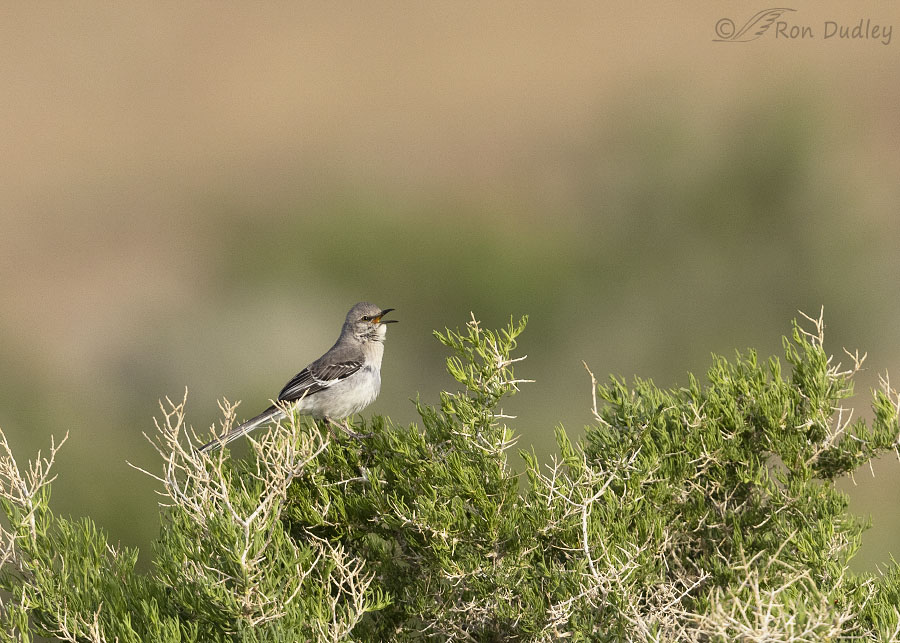
Yesterday morning I heard this male Northern Mockingbird long before I finally located him. He was singing constantly but he was far away and partially buried in the greasewood bush. I finally located him when he performed his very conspicuous “flight display” which made him much easier to see. But the first time he performed the display I hadn’t maneuvered my pickup into position to photograph him so all I could do was hope he’d do it again.
He did, but only once before he moved off to another greasewood even further away. I knew what to expect because I’d seen and photographed the behavior years ago.
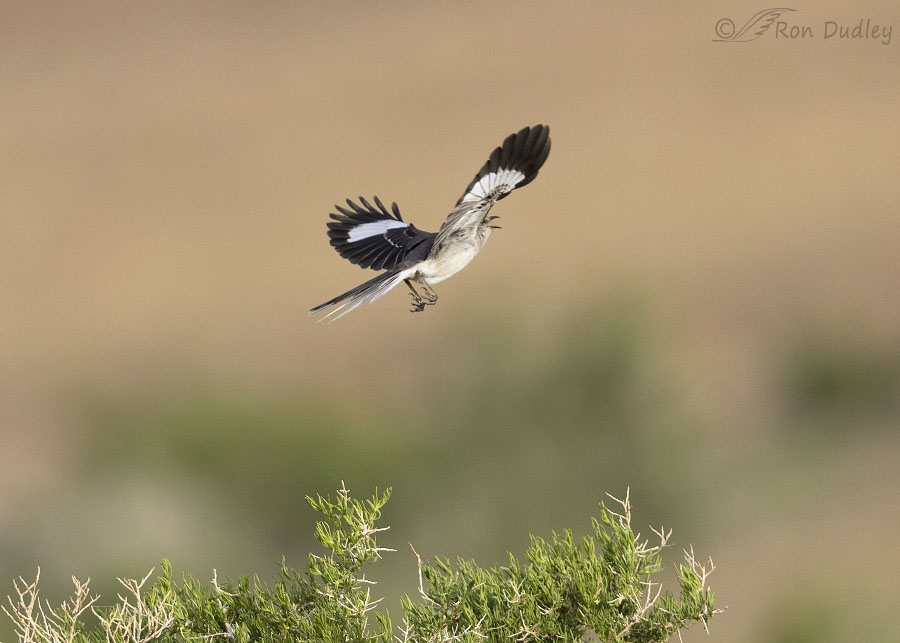
He launched himself almost straight up from the greasewood, going….
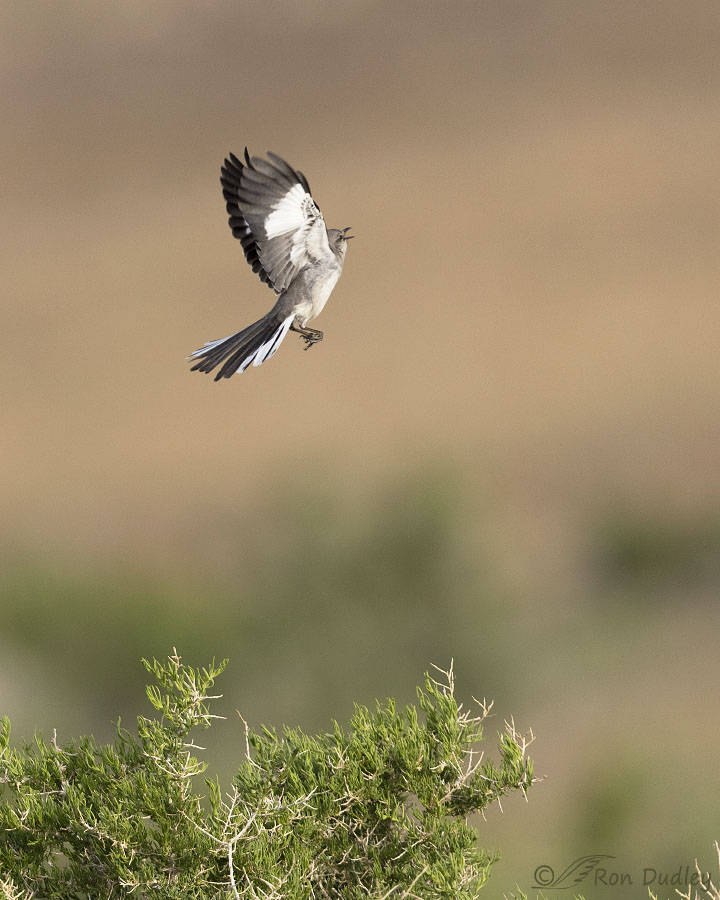
higher and higher with…
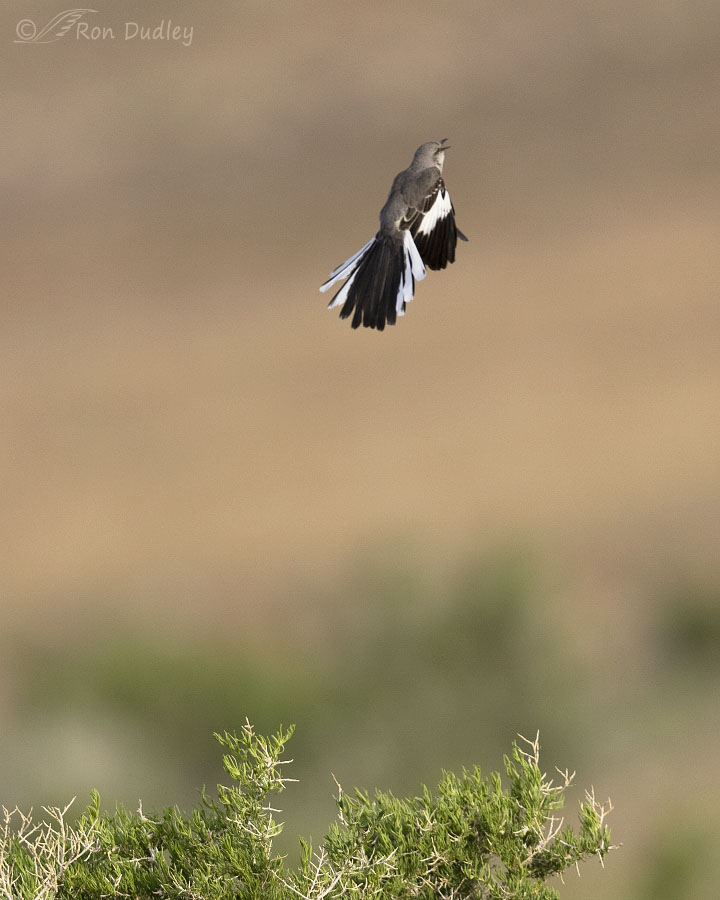
each click of my shutter. During his vertical ascent he was…
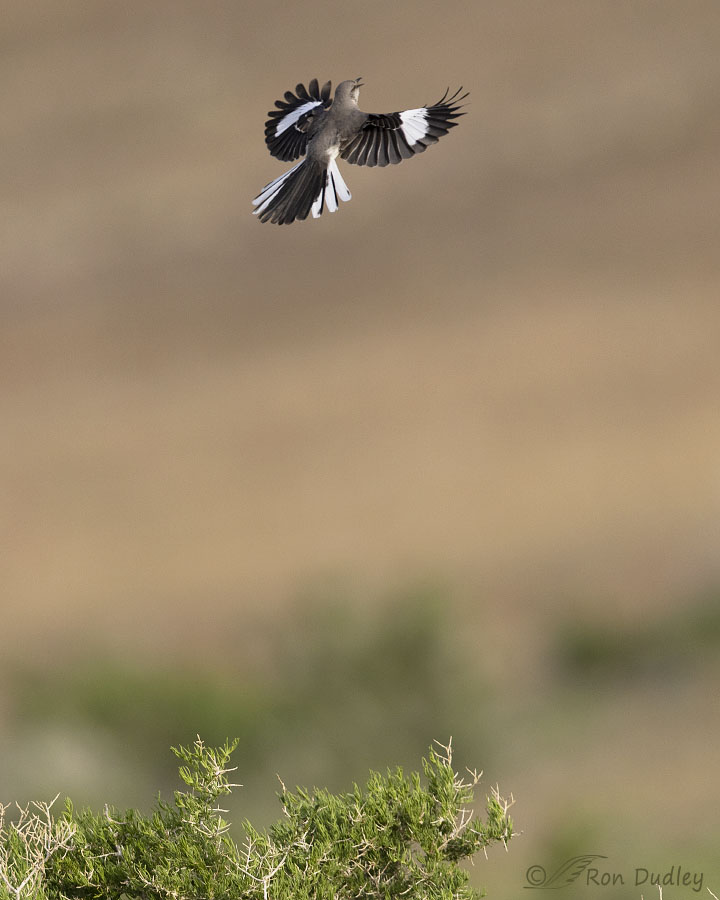
singing the entire time. He ascended so high and so fast I lost him in my viewfinder, even though I knew beforehand what he was going to do. It’s a very difficult behavior to photograph well.
Cornell’s Birds of the World states that during the display the male only ascends “a meter or two above the perch” but this guy outperformed that height by a very large margin. Both times I saw him perform the display he ascended to at least 20′ above the greasewood, maybe more.
I got a few photos of him as he was dropping back down to the same perch but they were quite soft so I’m not including them.
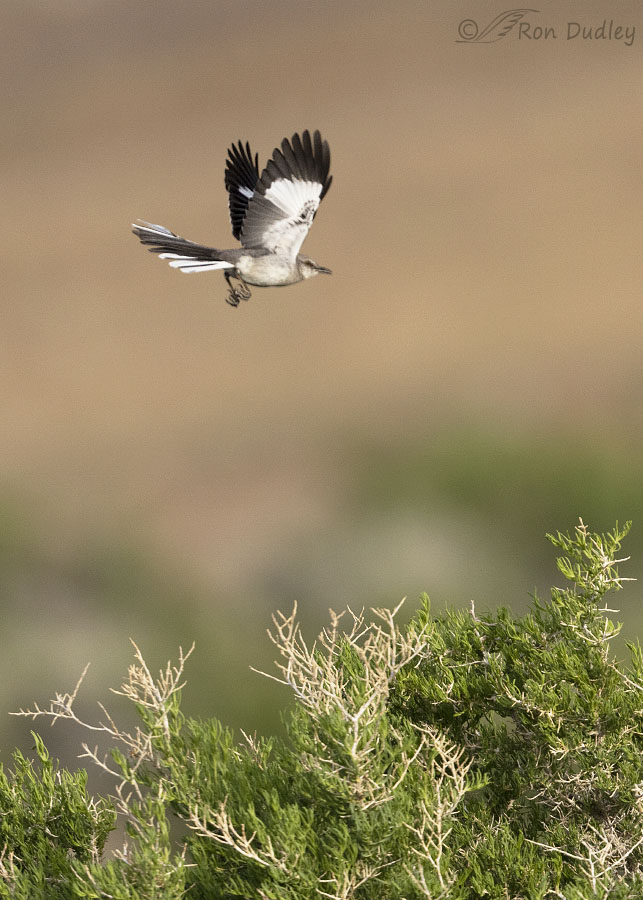
This is the first shot I got of his descent that was sharp enough (just barely) to include. When he first began his descent straight down he was falling head first but as he got closer to the greasewood he turned into a more horizontal position and “parachuted” the rest of the way down, with his flared tail and partially spread wings slowing his descent.
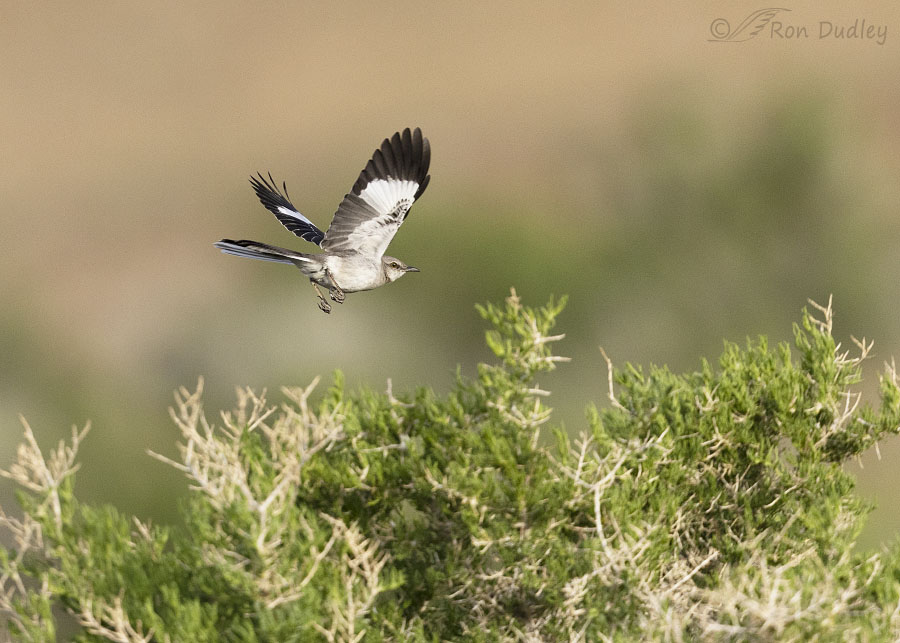
This is the last shot I got where we can still see the bird because he landed on the back side of the greasewood where he was hidden from view (which explains why the bird is sharp and the greasewood is soft). But if you study the bush you can tell that he landed only a few inches to the right of where he originally took off.
The “flight display” is a courtship display performed only by males, usually by unmated territorial males. I didn’t see any other mockingbirds nearby but I could hear one much further away.
This bird photographer would really like another chance at photographing the display before it’s over for the season. With my new camera I think I have a better chance of photographing it from beginning to end and getting most of the photos sharp.
My performance yesterday fell more than a little short.
Ron
Note: Here’s most of what Cornell’s Birds of the World has to say about this behavior.
“A “flight display” is given from a high singing perch. A singing male jumps upward, flaps his wings once or several times, ascends a meter or two above the perch, and then parachutes down, wings open, onto the same or a nearby perch. White wing patches are conspicuous during the display, and the bird sings continuously.”


What a great photographer you are. These are such fantastic photos. Each and everyone of them. So enjoyed.
Just one more thing. I did not read what you wrote. After mothers day lunch I certainly will and look forward to it. I also love to photograph the Mockingbird. But, your pics are the best.
What an incredible thing to see. And at least partially capture. I would love to see this and hope that this ambitious boy (leaping twenty times higher than expected!!!!) suitably impresses rivals and potential mates.
If any mockingbird could impress it would certainly be this one, EC. I’ve seen this display before but the other mockingbirds never flew this high while it was occurring.
Very neat you caught it. I posted a phone video of the one doing this at our condo. He picked the light post on the corner of a three story building for his stage. Too high for decent photos. I watched him pellet and tried for photos but it was so fast my camera missed the ejection moment and all I have is the pellet on the top of the light. Like your observation he flew higher in his display and also I am sure this male had a mate in the tree outside out condo. I saw the female catching insects and eating berries in the area. I could see the nest in the tree, it is a big tangle of what looks like loosely tangled sticks and some old grass and bits of garbage too. Both birds returned to the nest with food. He would spend part of the day in the same tree singing but not displaying like on the light post. Do they mate with more than one female?
“Do they mate with more than one female?”
April, here’s what Cornell has to say on the subject.
“Monogamous, usually for the length of a breeding season but occasionally for life,”
I’ve stopped to watch our neighborhood Mockingbirds perform many times over the years. It is a sight to see. So. I really enjoyed your stills catching this exuberant display. Their ability to mimic other birds (and car alarms) is amazing. Been fooled by them many times. This one in our neighborhood can do a Kestrel better than a Kestrel!
Thanks, Michael I especially enjoyed your last sentence!
Ron,
Great series. I’d love to hear and see the display.
Stephen
Thanks, Stephen. I’d love to hear and see it again!
yep, year-around here in Laguna Beach. They sing in the middle of the night! One near us, does his ‘display’ from the top of a street light. Fun to watch!
“Fun to watch”
I’ll bet it is, Barbara. A dose of nature in an urban setting.
WOW! Mockingbirds are very common in Scottsdale, AZ. While I love their singing my husband finds them annoying. We have one that ‘lives’ on our chimney so his singing travels through the chute into the house. Thanks for teaching me about this mating behavior – will look for it!
Kathleen, as much as I like mockingbirds I’d find it annoying if they lived in my chimney too!
Thank you, Ron! Laid up here in New England with Covid its a pleasure to see these photos and dream of soaring again!
Dang, I’m sorry you’re ill, Mary. So far I’ve avoided it. Feel better soon!
What an absolute demonstration of joy! Terrific/beautiful photos.
Thank You!
Thanks very much, Kaye.
In that third photo the mockingbird appears so joyous it is impossible to look at without smiling. Great series, Ron.
I agree, Cathryn – he sure seemed to be enjoying life. In contrast, at the exact same time I was being eaten alive by hordes of biting gnats, the island’s notorious no-see-ums.
Cool display and nice captures!
Thanks, Bruce.
That is one outstanding series Ron. Love those ascending shots with the mouth wide open singing away. Interesting commentary as well. We show them as fairly common here during their season, but I have only seen and photographed one once. That fourth photo with the wings up is really good.
Thanks, Everett. I’m jealous of folks in places like Las Vegas and southern CA where mockingbirds seem to be extremely common, at least in my experience. But even chances at mockingbirds won’t get me back to southern CA again, not ever. Their insane traffic puts me too close to having a heart attack. I kid you not.
WOW– now THAT’S a DISPLAY ! I hope a potential mate was close enough
to admire it, because he could wear himself right out if he had to repeat it lots
of times– but then the ability to repeat such a performance multiple times would be proof of superior vigor……wonderful that you can capture it for us to see.
Kris, when I photographed the behavior years ago the male repeated the display many, many times. But even though I had lots of chances my skills back then weren’t up to the task so I didn’t get very many sharp shots.
WOW! Beautiful and fun series – he REALLY put on a display….. Hope you get a “rerun”….
Hope you get a “rerun”….
“Hope you get a “rerun”.”
So do I, Judy. Big time! I said recently that with bird photography there are no “do-overs”. I hope this behavior will be an exception.
I enjoyed his performance and yours vey much. I’ve never seen a Mockingbird and certainly wasn’t aware of his courtship behavior. An excellent beginning to the day.
Much appreciated, Lyle. Hopefully next time, if there is a next time, I’ll get more sharp images of the behavior.
Great series and thanks for the behavior lesson!
Thank you, Cindy.